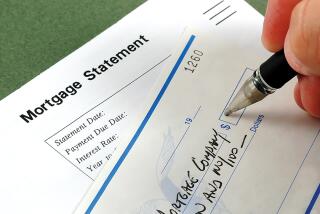Equity Loans Aid Top Earners Most
WASHINGTON — One of the most valuable federal incentives set aside for homeowners but denied renters--the ability to borrow money for consumer expenditures and deduct interest payments on federal tax filings--has become virtually the preserve of baby boomers with higher than average incomes.
A new national study of home equity lending by the Consumer Bankers Assn. has found that the typical borrower with a home equity line of credit is between 35 and 49 and has an annual household income close to $60,000. Fifty-one percent of all home equity line borrowers at a national sample of commercial banks and thrift institutions fit that age description. Twenty-seven percent of borrowers are 50 to 64 years old.
The No. 1 reason for taking out the credit line, according to the study: Debt consolidation--that is, paying off higher-rate consumer debt like credit card balances and unsecured personal loans with lower-cost home equity dollars.
Although home builders and realty brokers often don’t highlight it in their marketing pitches, the prospect of lower-cost consumer borrowing against equity is a major financial benefit of owning--not renting--a house or condominium under current federal tax laws.
A homeowner with $25,000 in credit card and revolving charge account debts at 17% and 18% can roll them together and replace them with a home equity line of credit carrying a rate of 9 1/2% or less. The home equity line interest is also likely to be deductible for federal tax purposes, lowering the after-tax effective rate paid by the owner well below 9 1/2%.
By contrast, a renter with $25,000 in high-rate personal debt has no tax-assisted alternative. Interest payments on unsecured personal loan debts under the federal tax code are not deductible. The interest on home equity-secured loans or lines up to $100,000 generally is deductible on principal residences. Home equity loans usually carry fixed repayment terms typically ranging from five to 15 years; credit lines allow a borrower to draw down varying amounts as needed.
The new study, conducted for the Consumer Bankers Assn. by two professors at the University of Virginia, examined home equity loan portfolios at a representative group of financial institutions across the country with assets of $100 million or more each. The institutions surveyed have more than 1 million equity loans or lines of credit outstanding, with an aggregate value of $36 billion.
Once a backwater of American lending, home equity borrowing has boomed since the 1980s into a huge business segment for banks. The study found that at the financial institutions surveyed this year, aggregate home equity-related credit “now represents over half of all consumer credit.” Equity lines of credit alone represent 34% of all consumer credit, excluding unsecured credit cards.
Banks flood consumers with home-equity offers because they’re profitable and carry relatively low risk of default--sometimes lower than even primary mortgages. In the new survey, the average home equity line borrower not only was a baby boomer with a solid income but was highly stable in his or her profession (held the same job for the last eight years) and place of residence (owned the same home for the last nine years).
After debt consolidation, the second most common use of home equity loans or lines of credit was for home improvement projects. Nine percent of home equity loan borrowers and 8% of borrowers with lines of credit use their equity dollars to buy or finance their personal automobiles. Other top uses for credit lines: to pay for education expenses, business investment, vacations, tax bills and medical bills.
The study also looked at how borrowers access their equity credit lines. Although the overwhelming favorite method was through the use of checks, 28% of the participating institutions allow their home equity borrowers to use automated teller machines, 11% allow credit cards and 15% allow debit cards for turning real estate into spendable cash.
*
Distributed by the Washington Post Writers Group.
More to Read
Inside the business of entertainment
The Wide Shot brings you news, analysis and insights on everything from streaming wars to production — and what it all means for the future.
You may occasionally receive promotional content from the Los Angeles Times.










